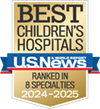Le Bonheur uses new techniques for better language mapping
Researchers at Le Bonheur’s Neuroscience Institute are using subdural high gamma elecrocorticographic (ECoG) recordings to better map areas of the brain which control a patient’s speech capabilities before surgery for brain tumors and epilepsy. Over the last 50 years, cortical stimulation mapping (CSM) has been used as the gold standard to localize the function of brain regions. One of the most promising alternatives to CMS is subdural high gamma elecrocorticographic (ECoG) recordings.
ECoG recordings in the high gamma (>50 Hz) frequency band provides researchers a reliable and accurate tool for language mapping, said Le Bonheur’s Abbas Babajani-Feremi, PhD, who leads the use of high gamma ECoG. The method provides a detailed map to show language-specific brain areas. It also reduces the time requirements of the CSM and eliminates the risk of producing seizures during passive ECoG recordings.
“A benefit of high gamma ECoG is that it can map function of the seizure onset zone,” Babajani-Feremi said. “Language-specific brain areas show high gamma activity during a language task, and based on that I can map the brain to see which area is related to language and which area is not.”
In addition to ECoG and CSM, Le Bonheur physicians also use magnetoencephalography (MEG), transcranial magnetic stimulation (TMS), and functional magnetic resonance imaging (fMRI) as non-invasive tools in pre-surgical planning, particularly for mapping language functions.
Multiple methods of pre-surgical language mapping provides safer, more detailed and more reliable information.
“Using high gamma and other pre-surgical mapping techniques, in addition to cortical stimulation mapping, we will be confident to get an optimal surgical outcome in our patients,” Babajani-Feremi said. “With all of this information, doctors will be able to get better information and make an optimal decision for surgery.”
Help us provide the best care for kids.
Le Bonheur Children's Hospital depends on the generosity of friends like you to help us serve 250,000 children each year, regardless of their family’s ability to pay. Every gift helps us improve the lives of children.
Donate Now










